Antibody data
- Antibody Data
- Antigen structure
- References [1]
- Comments [0]
- Validations
- Immunocytochemistry [1]
- Immunohistochemistry [4]
- Other assay [2]
Submit
Validation data
Reference
Comment
Report error
- Product number
- PA5-60685 - Provider product page

- Provider
- Invitrogen Antibodies
- Product name
- DHX40 Polyclonal Antibody
- Antibody type
- Polyclonal
- Antigen
- Recombinant protein fragment
- Description
- Immunogen sequence: SVGRTFCTMD GRGSPVHIHP SSALHEQETK LEWIIFHEVL VTTKVYARIV CPIRYEWVRD LLPKLHEFNA HDLSSVARRE VREDARRRWT NKENVKQLKD GISKDVLKKM QRRNDDKSIS DARARF Highest antigen sequence identity to the following orthologs: Mouse - 97%, Rat - 96%.
- Reactivity
- Human
- Host
- Rabbit
- Isotype
- IgG
- Vial size
- 100 μL
- Concentration
- 0.05 mg/mL
- Storage
- Store at 4°C short term. For long term storage, store at -20°C, avoiding freeze/thaw cycles.
Submitted references Identification and Characterization of USP7 Targets in Cancer Cells.
Georges A, Marcon E, Greenblatt J, Frappier L
Scientific reports 2018 Oct 26;8(1):15833
Scientific reports 2018 Oct 26;8(1):15833
No comments: Submit comment
Supportive validation
- Submitted by
- Invitrogen Antibodies (provider)
- Main image
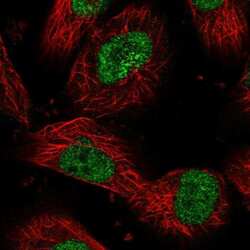
- Experimental details
- Immunofluorecent analysis of DHX40 in human cell line U-251 MG using DHX40 Polyclonal Antibody (Product # PA5-60685). Staining shows localization to nucleoplasm.
Supportive validation
- Submitted by
- Invitrogen Antibodies (provider)
- Main image
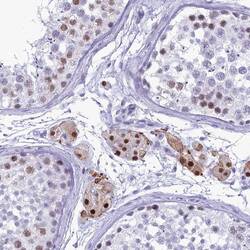
- Experimental details
- Immunohistochemical analysis of DHX40 in human testis using DHX40 Polyclonal Antibody (Product # PA5-60685) shows strong nuclear positivity in Leydig cells, as well as moderate positivity in cells in seminiferous tubules.
- Submitted by
- Invitrogen Antibodies (provider)
- Main image
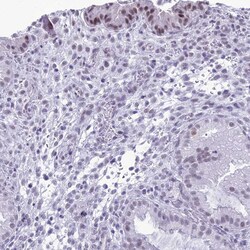
- Experimental details
- Immunohistochemical analysis of DHX40 in human endometrium using DHX40 Polyclonal Antibody (Product # PA5-60685) shows weak to moderate nuclear positivity in a subset of glandular cells.
- Submitted by
- Invitrogen Antibodies (provider)
- Main image
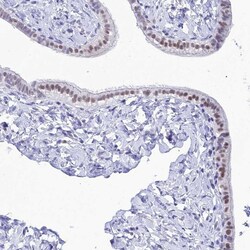
- Experimental details
- Immunohistochemical analysis of DHX40 in human fallopian tube using DHX40 Polyclonal Antibody (Product # PA5-60685) shows weak to moderate nuclear positivity in glandular cells.
- Submitted by
- Invitrogen Antibodies (provider)
- Main image
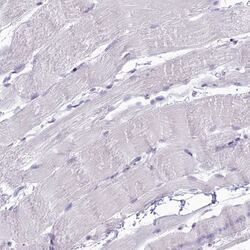
- Experimental details
- Immunohistochemical analysis of DHX40 in human skeletal muscle using DHX40 Polyclonal Antibody (Product # PA5-60685) shows no positivity in myocytes as expected.
Supportive validation
- Submitted by
- Invitrogen Antibodies (provider)
- Main image
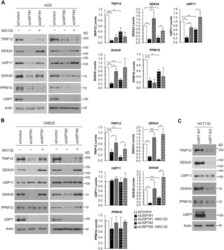
- Experimental details
- Figure 4 Effects of USP7 depletion on target protein levels. ( A , B ) AGS ( A ) or CNE2Z ( B ) cells were transfected with two different siRNAs targeting USP7 (#1 or #2) or a negative control siRNA (siControl) followed by treatment with the MG132 proteasome inhibitor (+) or DMSO as a negative control (-). Cell lysates were analyzed by Western blotting using the indicated antibodies. For each condition, the protein bands for TRIP12, DDX24, USP11, DHX40 and PPM1G were quantified in three independent USP7 silencing experiments (+/-MG132) and normalized to actin. The bar graphs to the right of the Western blots show the average values relative to the silencing control for each protein. P values for siUSP7#1 or 2 are indicated relative to siControl and p values for siUSP7#1/2 + MG132 are indicated relative to siUSP7#1/2 without MG132 (*0.01 < P < 0.05; **0.001 < P < 0.01; *** P < 0.001). ( C ) Whole cell lysates of HCT116 cells (WT) or HCT116 with USP7 knockout (KO) were analyzed by Western blotting as in ( A ).
- Submitted by
- Invitrogen Antibodies (provider)
- Main image
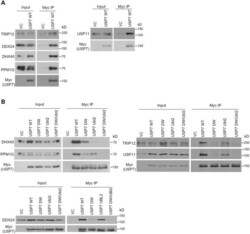
- Experimental details
- Figure 1 Coimmunoprecipitation of USP7 target proteins with WT and binding pocket mutations of USP7. ( A ) AGS cell were transfected with a plasmid expressing myc-tagged USP7 or an empty myc plasmid control (VC). Myc-USP7 was immunoprecipitated with anti-myc resin and recovered proteins were analyzed by Western blotting using antibodies against myc and the indicated endogenous proteins. ( B ) CNE2Z cells were transfected with empty vector control (VC) plasmid or plasmids expressing myc-tagged USP7 with WT sequence or with mutations in the TRAF (DW), or Ubl2 binding pocket or both binding pockets (DW/Ubl2). Myc-USP7 was recovered by Myc immunoprecipitation, followed by Western blotting as in ( A ).
 Explore
Explore Validate
Validate Learn
Learn Western blot
Western blot Immunocytochemistry
Immunocytochemistry